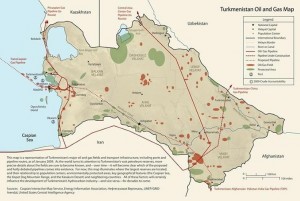Turkmenistan pipeline from east to west to be completed this year
A source at Turkmenneftegazstroi is reported as saying the Turkmenistan pipeline from Dauletabad in the southeast to the Caspian Sea coast (“East-West Pipeline” or EWP) for natural gas (see dotted line across south in the map) will be completed in December 2015. The report affirms, as commented here four and a half years ago, that construction on the 773-kilometer pipeline began in May 2010.
Contents
Importance of the Turkmenistan Pipeline
As the headline in the secondary report by Silk Road Reporters notes, this is part of the unification of the Turkmenistan gas transport system. Or, as I also wrote in 2010:
Construction of the East-West Pipeline will contribute to the ongoing unification of Turkmenistan’s gas supply system, which has been under way, generally unremarked, for some time. Yet the consequences are considerable. In particular: with the additional planned construction of a connection between Dauletabad and the new South Yolotan-Osman field, it will become possible for Turkmenistan, merely by opening and closing the proper valves, to switch export quantities and export directions among north (Kazakhstan, Russia), south (Iran, Afghanistan, Pakistan, India), east (Uzbekistan, Kazakhstan, China), and west (Azerbaijan, Georgia, Turkey, Europe).
The Turkmenistan pipeline across the south of the country will still need at least a half-dozen (likely seven or eight) compressors to pump gas to the Caspian coast, whence a Trans-Caspian Gas Pipeline (TCGP) might take it to the South Caucasus, whence through Turkey to Europe: of course, no longer through Nabucco but rather through an expanded TANAP.
The projected TCGP volume has always been 30 billion cubic meters per year (bcm/y), which by coincidence is also the volume of the Turkmenistan pipeline from east to west across the southern reaches of the country. The approximate cost of construction is $2 billion, and some foreign companies are participating despite the Turkmenistani wish to do as much as possible by themselves.
Alternatives to the Turkmenistan Pipeline
As Catherine Ann Fitzpatrick has noted, other possibilities have been bruited in the past such as compressed natural gas (CNG) and liquefied natural gas (LNG) from Turkmenistan to Azerbaijan, but the last time there were public reports of a Western company examining the question in depth, five years ago, the quantities appear to have been insufficient to be of economic interest.
The CNG would have come from gas by-product of oil production, currently flared into the atmosphere. Since then, the Western company involved, Italy’s Eni, is diverging its international energy development policy more and more from Gazprom, although there are still ties that bind.
The current technical problem with implementing, on the one hand, an LNG solution would appear to be is that (despite recent advances including offshore floating terminals) relatively larger quantities are required to make good the investment, than for CNG. In 2009 Turkmenistan produced only 276,000 tonnes of LNG, equivalent to only about 380 million cubic meters, which quantity is not quite worth it from the trans-Caspian angle.
A pertinent question about implementing CNG, on the other hand, would be who would build the ships and where, since they can’t be reasonably towed overland and dumped into the Caspian: any solution to this problem, such as flying or trucking in parts or materials that are not locally available, adds to costs.
Turkmenistan Pipeline: Its Current Significance
The original report attributed to Turkmenneftegazstroi, about the Turkmenistan pipeline EWP, interestingly comes two days before the European Union lays out, in a press conference, its vision of the Energy Union that has been much discussed over the last weeks and months. A typically skeptical article in Der Spiegel criticizes “the so-called EU Energy Union” for its decision to push for a Turkmenistan-Azerbaijan Memorandum of Understanding (MoU) by the end of the year. But such a push in fact makes some sense, since the EU signed a bilateral MoU on Energy with Turkmenistan in 2008 and one with Azerbaijan in 2014.

